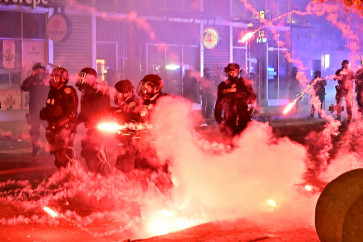Popular Reads
Top Results
Can't find what you're looking for?
View all search resultsPopular Reads
Top Results
Can't find what you're looking for?
View all search resultsSizing up saw wavescapes is a key to success
In the Book of Ecclesiastes, it is written: "I hated all my labour which I had taken under the sun: because I should leave it unto the man that shall be after me
Change text size
Gift Premium Articles
to Anyone

I
n the Book of Ecclesiastes, it is written: "I hated all my labour which I had taken under the sun: because I should leave it unto the man that shall be after me."
This lamentation is likely to resonate with many leaders in different walks of life, who are operating in what I call "saw wavescapes". Sharply contrasting with commonly expected linear trajectories, the development of these arenas resembles the jagged pattern of a sawtooth wave in acoustics. The radical metaphor shift from well-structured and predictable parcours to treacherous sawtooth arena in the domain of strategic analysis is the equivalent of viewing companies as tribes instead of as machines in the area of organizational design.
Let me discuss two of the stylized features that characterize saw wavescapes.
1. Sudden reversals of prospects and fortunes
In saw wave milieus, the outlook of the environment, such as a particular industry, can change drastically overnight because of various shocks. The availability of opportunities and resources can fluctuate dramatically between munificence and scarcity. Prices often follow a rollercoaster ride.
The amplitude of swings is great, with market sentiment oscillating between a gold rush feeling and utter despair. The development path of organizations in such settings oftentimes is similarly erratic.
Industry and organizational growth can well follow a linear path to the peak - deceiving analysts and prompting them to extrapolate positive trends. A cadre of na*ve chartists earns a fortune by visually examining graphs to calculate the slope of future trajectories based on the past. This approach seems to be scientific but in reality is utterly futile, since the possible occurrence of needle-shifting shocks is not built into the elegant models. A slump thus often surprises the experts who painted a rosy picture of the future.
Industries and organizations do not develop in smooth cycles. Instead, the growth pattern is highly erratic; the edges of the growth trajectory are sharp. Negative changes come in heavy blows, resulting in a sharp dent in the growth curve. To put it figuratively: Torrential rain is accompanied by thunderbolts. The sudden crash is similar to the outburst of a person who has silently accumulated aggressive energy because of countless humiliations.
Extraordinarily bright sunshine in an industry can well hide and equal in intensity the problems that are accumulating beneath the shiny surface.
The resulting development pattern does not resemble the progression of four seasons, as in Germany, with gradual changes between them. Nor is it similar to the one season monotony in Singapore. Rather, we often witness a distinctive three-season sequence. A long spring is followed by a short hot summer, and then - the Indian summer is skipped - winter suddenly breaks in.
The good news is that in saw wave settings, there is potential for an eventual recovery, which albeit usually is gradual. When the sun rises again, the augurs again are often startled. A bubble is not an apt metaphor for describing such environments, because when it bursts, the game is over. Historically, many technological breakthroughs with genuine potential led to unsustainable valuations at first. This was due to what turned out to be overexcitement and overconfidence of market participants exposed to euphoric reports and other influences. But after the collapse, the new industry recovered, like phoenix from the ashes.
Because of these properties, a bubble is also not a very helpful concept for managers, who want to struggle on after a crash instead of giving up.
As in physics, saw waves in social systems can start in either direction. The initial pattern of a reverse saw wave, which starts with a decline, contrasts with the traditional upward-sloping S-curve, where there is at least some progress at the beginning. Departing from the ideal type in physics, in the case of a reverse saw wave in a social system, the peak reached after the recovery that follows the first dip can far exceed the departure value. In such cases, the potential for wrong decisions is high. If the organizational policy is to eliminate growth options as early as possible, many a promising seed might not be nurtured long enough to bear fruits.
Despite the unexpectedness of many reversals, there is regularity with respect to the essential zigzag pattern of boom alternating with bust. Windows of opportunities open, close and then, just when all seems to be lost, reopen. Barriers routinely are lifted, only to be shut and then yet again raised thereafter. There is a basic traffic light pattern, with pivotal stakeholders alternating between displaying green and red signals. There is often no clear warning of imminent punitive strikes. To use an analogy from soccer: Red cards are frequently shown without prior caution by means of a reprimand or yellow card.
2. High inflammability and explosiveness
A saw wave arena can be easily ignited and tends to explode. As in the case of a house made of dry wood, a single spark can suffice to set the whole structure on fire. Every impression of lasting tranquility is deceptive in a "pendulum arena", because volatility is in-built.
Small things can make a big difference in such fluid settings. They can change the needle, causing unexpected triumphs and sudden falls. It is not uncommon for David to win against Goliath in these environments. In fact, one activist, Jeff Ballinger, who was upset about the labor practices at the factories of Nike's contractors in Indonesia, wrought havoc on the corporate giant. Mounting a highly targeted "one country-one company" campaign, he leveraged the visibility of Nike for his own purposes.
Ballinger cleverly associated the high-profile company with the reproachable labor practices and then rode on the resulting saw wave of negative publicity about his target. What had contributed heavily to Nike's success in the past - leveraging subcontractors in low-cost locations - was the seed of a major unexpected crisis.
In the brave new sawtooth world, the future belongs to those helmsmen who can adopt a saw wave perspective, fathom the distinguishing features of their internal and external environments, and adjust their strategic leadership approach accordingly.
"Prof. Kai on Strategic Leadership" Column Number 43. Kai-Alexander Schlevogt (D.Phil. Oxford), a former professor at NUS Business School, is Area Editor, Asia-Pacific, of Performance (global journal published by Ernst & Young). He wrote The Innovation Honeymoon and The Art of Chinese Management. Email: schlevogt@schlevogt.com; website: www.schlevogt.com.









